Opinion & Analysis
Part 2: Taking Shaft Fitting from Guessing to Specifics
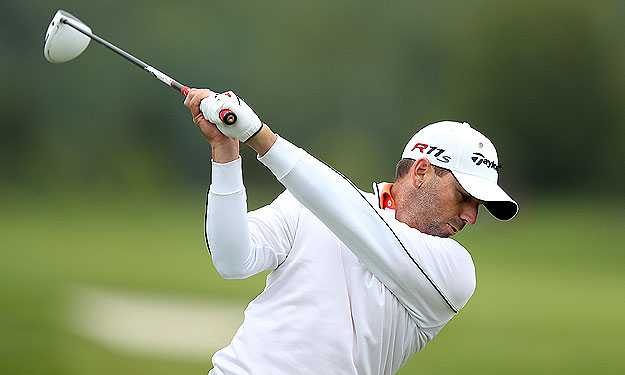
How Should a Golfer Select the Right Shaft for His/Her Swing?
One of the most common posts I see on GolfWRX is when one golfer asks other golfers for a shaft recommendation. These posts seldom say anything about a golfer’s swing characteristics, other than his or her handicap and sometimes a clubhead speed.
Invariably, many different shaft recommendations follow, but rarely is there a follow-up question to ask the golfer anything more about his or her particular swing characteristics.
Shafts do not perform the same way for all golfers. Shafts perform differently for different swing characteristics because different swing characteristics make shafts bend and twist differently. Most golfers are aware that their clubhead speed has relevance to what shaft they should play. But in addition to the clubhead speed, there are several other swing characteristics which determine how different shafts can and do perform differently for different golfers.
Shafts are in essence “dumb animals.” There is absolutely NO magic to the performance of a shaft. They ONLY do what their owner’s swing characteristics ordain them to do.
For some golfers, there is some additional performance contribution from the center of gravity location inside the clubhead. However, there are a lot of different variations in how golfers swing the club with respect to the specific swing characteristics that dictate how a shaft will perform. The whole idea of analyzing the swing characteristics that are pertinent to shaft performance is to allow us to have a way to systematically ELIMINATE shafts from consideration for a golfer, so what is left would be a smaller, manageable number of shafts with which each golfer could play.
The KEY elements of the golf swing in shaft fitting
1. Club Head Speed
The clubhead speed affords a basic, rudimentary, BEGINNING indication for the approximate overall amount of bending force a golfer may put on a shaft. However, it is very common for two golfers with the same clubhead speed to put totally different amounts of bending force on a shaft.
It is also common for two golfers who put the same bending force on a shaft to have different clubhead speeds. This is why a good shaft fitter has to analyze other characteristics of the golf swing to get more of an idea of how much bending force the golfer is putting on the shaft for his/her swing speed, when that bending force is being applied to the shaft and where on the shaft is the most bending force being applied.
Clubhead speed gives us a starting point to help us begin to narrow the choice of possible shafts for a golfer in the fitting process. But it only tells us a part of the story.
2. Downswing Transition Force
The force with which the golfer starts the downswing determines the initial bending force on the shaft. In other words, how much the shaft is initially “loaded” is chiefly determined by the golfer’s transition force to start the downswing.
Of two golfers with the same clubhead speed, the one with the stronger, more forceful transition will need a stiffer shaft (a shaft with a swing speed rating that is higher than the golfer’s swing speed). Of two golfers with the same clubhead speed, the one with the smoother, passive transition will need a more flexible shaft (a shaft with a lower clubhead speed rating than the golfer’s swing speed).
In addition, a golfer with a stronger transition typically is better fit into a HEAVIER weight shaft. A strong/forceful transition with a very light shaft can result in a swing tempo that gets too fast and too inconsistent, although it can be possible to use a higher than normal swingweight to allow a golfer with a strong transition to not get too quick when using a very light shaft.
3. Downswing Tempo/Downswing Aggressiveness
We said the transition force determines the INITIAL loading of the shaft. The downswing tempo determines how much that initial loading may change during the rest of the downswing before impact.
Tests we have performed with special sensors on the shaft reveal that it is extremely rare for a golfer to increase the loading of the shaft during the downswing. It is not very common for a golfer to maintain the same load on the shaft during the downswing, either. Almost every golfer loads the shaft the most at the beginning of the downswing, after which the loading on the shaft begins to decrease from the moment the transition turns into the downswing.
A good shaft fitter will analyze the downswing tempo to estimate if the golfer is maintaining their initial loading of the shaft, slightly losing some of the loading or substantially losing it. In more recent research, we have come to the belief that the transition and tempo blend together in terms of the golfer’s ability to put a bending force on the shaft and maintain it or not to the point of release. Hence the good shaft fitter will analyze the transition/tempo together in one overall observation to decide whether the golfer is an AGGRESSIVE HITTER, a SMOOTH SWINGER, somewhere in between or variations of each extreme.
It really is not necessary to split the hair too fine on this evaluation. Good fitters chiefly think in terms of HITTER, SWINGER or AVERAGE when it comes to evaluating the effect of the transition/tempo on the golfer’s ability to load the shaft.
How is the analysis of the golfer’s transition/tempo used to help narrow down the shaft recommendation?
The more forceful and aggressive the golfer’s transition/tempo, the more the shaft would be selected to have a swing speed rating that is a little higher than the actual swing speed of the golfer. Vice versa, the more passive, smooth and easy the golfer’s transition/tempo, the more the shaft would be selected to have a swing speed rating that is a little lower than the actual swing speed of the golfer.
For example, let’s say we have three golfers, each with a 100 mph clubhead speed.
- Golfer No. 1 has a short, three-quarter length backswing with a fast, forceful transition and an aggressive downswing.
- Golfer No. 2 has a normal backswing length with some sense of transition force and downswing aggressiveness but not nearly as much as Golfer No. 1.
- Golfer No. 3 has a smooth, rhythmic, almost passive transition and tempo that identifies him as far more of a “swinger” than a “hitter.”
For basic fitting, Golfer No. 2 would be advised to look among shafts that have a 95-to-105 mph swing speed rating because his swing characteristics are putting an average amount of bending force on the shaft for his 100 mph clubhead speed.
Golfer No. 1 (strong/forceful transition and tempo) would be advised to look among shafts that would have a 100-to-110mph swing speed rating because his swing characteristics are “loading” the shaft more from him putting an ABOVE average amount of bending force on the shaft for his 100 mph clubhead speed.
And Golfer No. 3 (smooth, passive transition and tempo) should choose from shafts that have a 90-to-100mph swing speed rating because his swing characteristics are “loading” the shaft much less for his speed and put a BELOW average amount of bending force on the shaft for his 100 mph clubhead speed.
Three golfers in this example all had the same clubhead speed, yet each put a different bending force on the shaft. The more forceful and aggressive the transition/tempo, the higher the swing speed rating of the shaft should be in comparison to the golfer’s clubhead speed. The more passive and smooth the transition/tempo, the lower the swing speed rating of the shaft should be in comparison to the golfer’s clubhead speed. And for the golfer with the average transition/tempo, the swing speed rating of the shaft should allow for the golfer’s clubhead speed to be right in the middle of that range.
Here’s a little different way to look at this relationship of clubhead speed and transition/tempo versus the bend profile stiffness measurements and the swing speed rating for shafts.
In short, as the golfer puts more bending force on the shaft due to his transition and tempo, the swing speed rating of the shaft needs to increase higher than the golfer’s actual clubhead speed. And as the golfer puts less bending force on the shaft due to his transition and tempo, the swing speed rating of the shaft needs to decrease lower than the golfer’s actual clubhead speed.
But what’s next after finding the shafts which have a swing speed rating that corresponds to the golfer’s clubhead speed and adjustments for the golfer’s transition and tempo?
4. Point of Wrist-Cock Release During the Downswing
The key swing characteristic that good shaft fitters analyze to determine the correct TIP STIFFNESS design of the shaft for the golfer is the point the golfer unhinges their wrist cock release on the downswing. In swing mechanics terms, the action of unhinging the wrist cock angle is called the RELEASE.
The point when the golfer releases the club is what determines WHEN the shaft goes from being “loaded” to being “unloaded.” The point when the golfer releases the club determines when the shaft moves from a “flexed back” position into a “flexed forward” position. The point of release also determines when the clubhead achieves its highest speed.
Once the golfer unhinges the wrist cock angle, the arms immediately begin to slow down while the clubhead speeds up. If the golfer releases the club too early, the clubhead reaches its highest speed well before it gets to the ball. With an early release, by the time the clubhead gets to the ball, the clubhead speed has slowed down. This slowing down of the clubhead before impact even happens for golfers who release the club midway on the downswing – though not as much as with an early release.
The only golfers who achieve their highest clubhead speed right when the clubhead meets the ball are golfers with a late release. Hence, this is another reason why a late release is such an important swing skill for golfers to achieve to be able to play to the best of their physical skills.
In shaft fitting terms, the later the golfer releases the club, the more tip stiff the shaft COULD be. And conversely, the earlier the golfer releases the club, the more tip flexible the shaft should be. Because the actual point of release can vary all the way from the start of the downswing to the very end, so too the tip stiffness design of the shaft is chosen to correspond.
- Early release = most tip flexible
- Latest release = most tip stiff
- Release in between early and very late = tip stiffness in between.
You can now start to see why we need to have quantitative stiffness measurements of shafts so we can choose the right level of stiffness for golfers with varying levels of transition/tempo force and different points of release. With only letters for flex and generic terms for tip stiffness or bend point, shaft fitting is little more than a trial-and-error guess.
Below is a chart that offers some examples for how to combine the golfer’s clubhead speed, transition/tempo evaluation and the golfer’s point of release to narrow the choices for a suitably fit shaft:
5. The Qualitative Side of Shaft Fitting: The Golfer’s Perception and Preference for the Shaft’s BENDING FEEL
Talk about something that can throw a monkey wrench into all the logical things that we have taught so far about shaft flex/bend profile fitting! If you want to know why some golfers play well with shafts that are “on paper” considered to be too stiff, too flexible, too tip stiff or too tip flexible for their clubhead speed, transition/tempo and point of release, this is the reason why.
If a golfer has developed a specific preference for a type of bending feel of the shaft during any point in the swing, that feel preference has to be THE GUIDING FACTOR in the shaft fitting process. During the fitting process, the smart, experienced clubfitter knows to interview the player and ask questions to assess the golfer’s level of perception for the bending feel of the shaft and whether they have acquired specific “likes and dislikes” for various aspects of the shaft’s bending feel during the swing.
The very best way to incorporate a golfer’s preference for shaft feel in the shaft fitting process is to have the golfer reveal specific shafts they have either liked or disliked in previous or current clubs. If these shaft models/flexes are searched in the Bend Profile Software we created, the stiffness measurements of those shafts can then be referenced against possible future shaft recommendations to determine if the new shaft selection may or may not satisfy the golfer’s shaft feel preferences.
One of the myths about shaft flex/bend profile performance is when someone states that this or that shaft is designed in a way that can actually increase the bending velocity of the shaft to offer a golfer a higher clubhead speed. This is impossible because of the physics of tube design and performance. However, it is very possible for a golfer to change to a different shaft flex/bend profile design and experience a measurable increase in clubhead speed.
How this happens is how the new shaft falls into the golfer’s preference for the bending feel of the shaft. Give a golfer a shaft that feels perfect in terms of how much it bends, when it bends and where it bends in relation to the golfer’s acquired preference for bending feel and that golfer will achieve his most free, most unrestricted and most fluid release through the ball. And it is from this – having a shaft that feels perfect in every way to the golfer – that they are able to achieve a higher clubhead speed.
On the other hand, put the golfer into a shaft that demonstrates a feeling of being too stiff or too flexible in some way compared to the golfer’s preference for bending feel and they most typically will begin to change their swing to make the shaft perform and feel as they prefer. Manipulating the swing means a lack of free motion, free unrestricted release and a lower clubhead speed with less swing consistency.
Again, to not have a truly quantitative way to analyze shafts, trying to turn a golfer’s feel preferences for the shaft into a valid new shaft recommendation becomes a trial and error process.
6. Putting It All Together
The higher the golfer’s clubhead speed, the more forceful/aggressive the transition and tempo, the later the release, the more the flex and the bend profile of the shaft become a contributor to the launch angle, trajectory and spin rate for the shot. The lower the clubhead speed, the more passive the transition and tempo, the earlier the release, the less important the shaft’s flex and bend profile are to performance. But for ALL golfers, the WEIGHT of the shaft is an important part of the shaft selection process.
The higher the golfer’s clubhead speed, the more forceful/aggressive the transition and tempo, and the later the release IN RELATION TO THE SWING SPEED RATING and TIP STIFFNESS OF THE SHAFT, the more the shaft can increase launch angle, trajectory and spin.
The shaft only just begins to contribute to launch angle, trajectory and spin in a gradual increasing manner as the golfer has a midway to later to very late release. Midway release, the flex and bend profile begin to matter a little. Very late release, the stiffness design of the shaft matters a lot more. For golfers with an early to before midway release, the flex and bend profile of the shaft do virtually nothing to the launch angle, trajectory and spin of the shot. The shaft’s WEIGHT becomes the only key shaft fitting factor for golfers with an early to before midway release.
The ONLY ways the shaft can lower launch angle, trajectory and spin is:
- If the shaft is either more stiff overall than the golfer’s previous/current shaft, or…
- If the tip section of the shaft is more stiff than the tip section in the golfer’s previous/current shaft.
Just because a shaft is said to be tip stiff will not reveal whether it is a lower spin shaft than what you play now. A shaft has to be more stiff overall and/or more tip stiff than what you play now to have any effect on lowering launch angle, trajectory and spin.
The golfer’s preferences for a specific bending feel of the shaft overshadow the stiffness and bend profile fitting analysis compiled from the clubhead speed, transition/tempo and point of release. In all cases for all golfers, you do go through the stiffness and bend profile fitting analysis compiled from the clubhead speed, transition/tempo and point of release, but you listen hard and consider modifying the recommendation when the golfer says they have a specific preference for the bending feel of a shaft.
Related
- Part 1 — Taking the guesswork out of selecting shafts
- Part 2 — Taking shaft fitting from guessing to specifics
- Part 3 — Facts about shafts, and what they do
- LIKE99
- LEGIT6
- WOW14
- LOL2
- IDHT0
- FLOP1
- OB1
- SHANK2
19th Hole
Vincenzi: The 8 best prop bets for the 2024 Masters
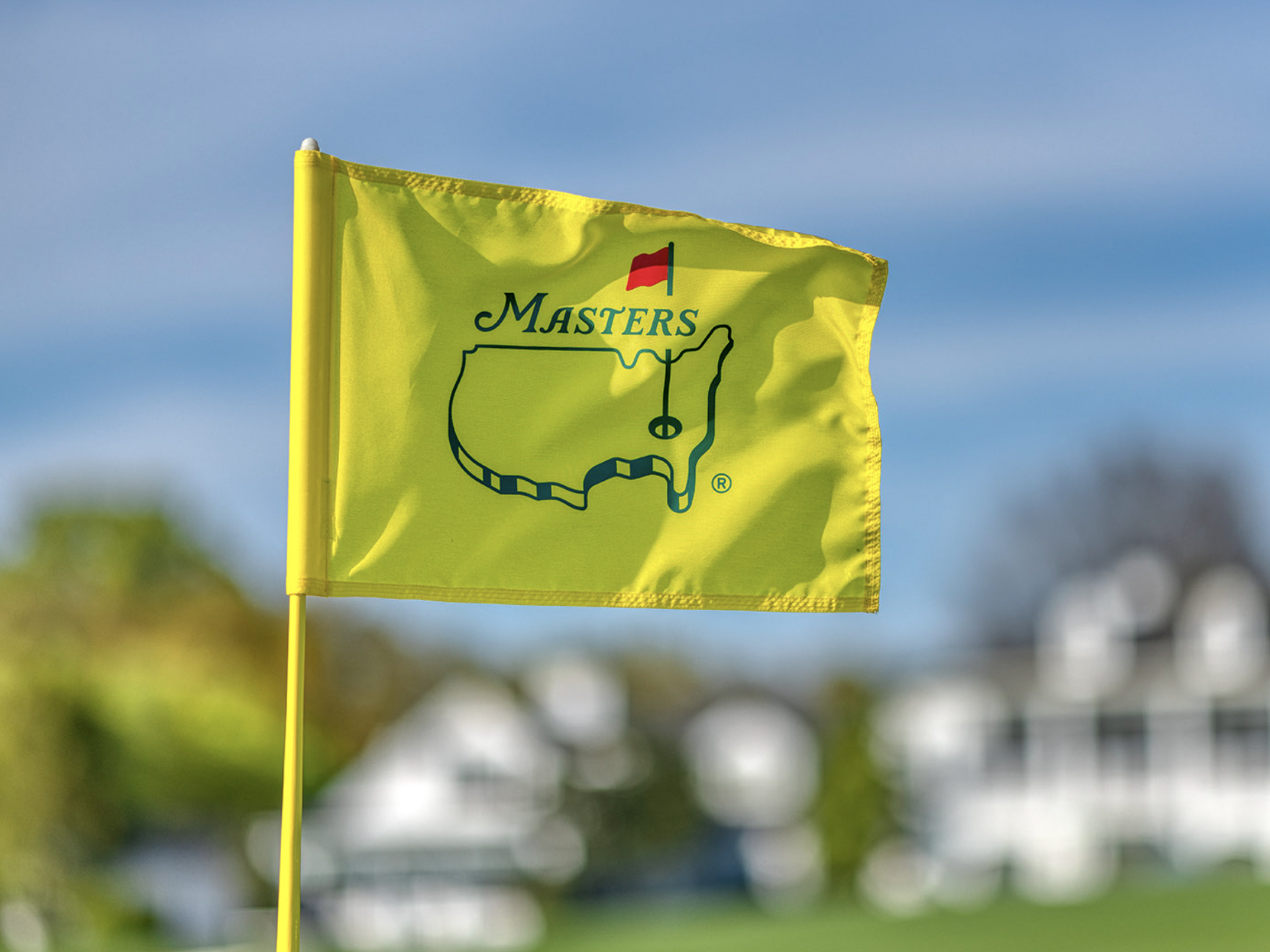
We’ve finally reached The Masters and excitement is at an all-time high. The world of golf has been fractured for the better part of two years, but for a week at Augusta National, all of the outside noise will disappear. All of the best players in the world will be together seeking to make history.
In addition to betting on The Masters champion. This is one of the few weeks of the year where there are so many more markets to explore, with value to be had in plenty of different categories.
Throughout this article, I’ll discuss all of my favorite props and players for the 2024 Masters.
Placement Bets:
Tony Finau Top 5 +750 (DraftKings):
I badly wanted to include Tony Finau in my outright betting selections, but I simply ran out of room on my card. Additionally, it’s slightly difficult to see him hitting the putts necessary to win the Masters on back nine on Sunday. However, I do strongly believe he will play great golf this week at Augusta National.
In his past 24 rounds, Finau ranks 4th in Strokes Gained: Approach is always amongst the best drivers of the golf ball in the game. Back in 2019, Finau had a great chance to win The Masters. I expect him to be hanging around over the weekend once again in 2024.
Gary Woodland Top 20 +550 (DraftKings), Gary Woodland to make the cut -110 (DraftKings):
Last season, Gary Woodland had his best ever finish at The Masters in his eleven tries. The 39-year-old finished T14 and played incredibly steady across all four rounds.
In Woodland’s most recent start at the Texas Children’s Houston Open, he struck the ball incredibly well. He led the field in Strokes Gained: Approach (+8.8) and Strokes Gained: Ball Striking (+10.0).
Gary has been working with Butch Harmon and absolutely flushing the ball both in tournaments and during practice.
Woodland appears to be healthy once again and in a great place physically and mentally. If he can build off his impressive performance at Augusta last year, he can place inside the top ten in 2024.
Additionally, the make the cut number on Woodland seems generous considering the number of players who miss the cut will be relatively small this week. Woodland is striking it well enough to make the cut even if he’s hindered by a balky putter once again.
Thorbjorn Olesen Top 20 +400 (FanDuel):
The Thunder Bear, Thorbjorn Olesen, made his Masters debut in 2013 and finished an incredibly impressive T6 for the week. In the two additional starts he’s made at Augusta National since then, the Dane has continued to be incredibly solid, finishing T44 and T21.
This week, Olesen heads into the week playing some good golf. He gained 3.8 strokes on approach and 5.52 strokes around the green at last week’s Valero Texas Open on his way to a strong T14 finish. Back in January, he won the Ras Al Khaimah Championship on the DP World Tour.
Olesen has the skill set to be successful at Augusta and seems primed for a good performance this week.
Top Nationalities:
Sergio Garcia Top Spanish Player +280 (DraftKings):
I believe Sergio Garcia can get into contention this week with the way he’s striking the ball in addition to his good vibes with a refurbished version of the Scotty Cameron that he used at the 1999 PGA Championship at Medinah.
I am slightly concerned about the emotional letdown he may face after losing in a playoff at LIV Miami, but I believe a veteran and former Masters champion should be able to regroup and focus on an event far more meaningful.
This is essentially a tournament head-to-head with Jon Rahm at +280. While Rahm deserves to be respected this week, the history of the lack of success of defending champions at The Masters is difficult to ignore.
Joaquin Niemann Top South American Player -230 (FanDuel):
While I hate paying this much juice, I don’t see a world in which Joaquin Niemann isn’t the top South American this week at The Masters. Joaco comes in playing better golf than anyone in the world not named Scottie Scheffler and has a serious chance to win the green jacket.
He only needs to beat two players: Emiliano Grillo and Camilo Villegas.
Tournament Head-to-Heads:
Justin Thomas -110 over Collin Morikawa
JT isn’t having his best season but is playing a lot better than he is getting credit for at the moment. In the past three months, there are only six players on the PGA Tour who have averaged 1.7 Strokes Gained: Tee to Green or better. Justin Thomas (+1.7) is one of the six and is currently tied with Rory McIlroy (+1.7).
Morikawa, on the other hand, has been extremely poor with his irons, which is incredibly uncharacteristic for him. I can’t help but feel like something is completely off with the two-time major champion.
Tony Finau -110 over Wyndham Clark
I explained in the placement section why I’m so high on Tony Finau this week. With how well he’s striking the ball, it seems as if his floor is extremely high. I’m not sure if he can make the putts to win a green jacket but I believe he will be in the mix similarly to 2019 when Tiger Woods emerged from a crowded pack of contenders.
Clark is a debutant, and while some debutants have had success at The Masters, it certainly poses a challenge. I also don’t believe Augusta National suits Clark as well as some of the other major championship venues.
- LIKE8
- LEGIT4
- WOW2
- LOL0
- IDHT0
- FLOP0
- OB0
- SHANK2
19th Hole
Vincenzi’s 2024 Masters betting preview: Niemann to play star role at Augusta National

It’s been over nine months since we saw Brian Harman parlay a dominant performance at Royal Liverpool into a claret jug. After another major offseason filled with a feud between the PGA Tour and LIV Golf, talks of a merger, and a multitude of questions regarding the future of the game, the golf world is desperate for all of the best players in the world to come together again for a major championship.
We return to Augusta National with excitement at a fever pitch. Scottie Scheffler has separated himself as the best player in the world heading into the Masters. At the moment, the 27-year-old seems to be an unstoppable force. However, questions about Scheffler’s up-and-down putter once again resurfaced as he missed multiple short putts at the Texas Children’s Houston Open including a 5’11” putt to force a playoff with Stephan Jaeger.
Additionally, a handful of the PGA Tour’s top players such as Justin Thomas, Rory McIlroy, Will Zalatoris, Patrick Cantlay, Tommy Fleetwood and Jordan Spieth make their way to Augusta National with their current form in question.
Plenty of LIV golfers may be up to the task of conquering Augusta, but with so much time in between the last two majors, it’s not always easy to decipher how their games will stack up against Scheffler and co.
Last year, some important changes were made at Augusta National. The par-5 13th (Azalea) was lengthened by 35 yards and now measures 545 yards. Last year, Azalea played as the toughest of the four par 5s, and players averaged 4.74 for the week, which was down from 4.85 in 2022. However, eagles, birdies and bogeys were all up, so the lengthening achieved less pars, which equals more excitement.
Without further ado, let’s get into the course breakdown and analyze some important statistics for Augusta National.
Augusta National is now a 7,510-yard par-72 with lightning-fast Bentgrass greens. The course’s primary defenses are the contoured greens, swirling crosswinds, the topography of the course, which creates uneven lies and the small landing areas that golfers will need to hit to avoid tight run-off areas around the greens.
Past Winners at the Masters
- 2023: Jon Rahm (-12)
- 2022: Scottie Scheffler (-10)
- 2021: Hideki Matsuyama (-10)
- 2020: Dustin Johnson (-20)
- 2019: Tiger Woods (-13)
- 2018: Patrick Reed (-15)
- 2017: Sergio Garcia (-9)
- 2016: Danny Willett (-5)
- 2015: Jordan Spieth (-18)
- 2014: Bubba Watson (-8)
- 2013: Adam Scott (-9)
- 2012: Bubba Watson (-10)
- 2011: Charl Schwartzel (-14)
- 2010: Phil Mickelson (-16)
In this article and going forward, I’ll be using the Rabbit Hole by Betsperts Golf data engine to develop my custom model. If you want to build your own model or check out all of the detailed stats, you can sign up using promo code: MATTVIN for 25% off any subscription package (yearly is best value).
Key Stats For Augusta National
Let’s take a look at the six most important metrics at Augusta National and determine which golfers boast top marks in each category over their last 24 rounds. This should give us a good starting point for building out a betting card.
Strokes Gained: Approach
Approach is historically the most important statistic at Augusta National. The sloping, speedy greens and run-off areas create small landing spots that can be difficult to hit.
Last year, Jon Rahm ranked 6th in the field in Strokes Gained: Approach. Overall, five of the past seven winners at Augusta have ranked in the top 6 in the category. Distance helps, but Augusta National is a second-shot golf course.
Total Strokes Gained: Approach in past 24 rounds:
- Scottie Scheffler (+1.30)
- Corey Conners (+0.99)
- Shane Lowry (+0.88)
- Tony Finau (+0.85)
- Austin Eckroat (+0.85)
Course History
More so than any other course on TOUR, familiarity with Augusta National is crucial. Only one player has ever won the Masters on their first try — Fuzzy Zoeller in 1979. Meanwhile, there are 17 golfers in history who have multiple green jackets.
In most cases, the Masters champion has shown some good form at Augusta in the past. Prior to Scottie Scheffler’s 2022 victory, he finished T19 and T18 in his first two trips to the course. Prior to 2023, Rahm had finished in the top-10 of four of his six starts at The Masters.
Total Strokes Gained: Total at Augusta National in past 36 rounds (per round, minimum eight rounds):
- Will Zalatoris (+2.91)
- Jon Rahm (+2.28)
- Jordan Spieth (+2.22)
- Scottie Scheffler (+2.22)
- Dustin Johnson (+2.01)
- Rory McIlroy (+2.00)
- Hideki Matsuyama (+1.90)
- Justin Rose (+1.85)
- Rickie Fowler (+1.72)
- Russell Henley (+1.60)
Par 4 Scoring Average
Since plenty of players can reach the par 5s at Augusta in two, par-4 scoring becomes more important. The golfer who separates themselves on the par 4s will be able to gain ground on the field.
Par 4 Scoring Average in past 24 rounds:
- Scottie Scheffler (+3.88)
- Chris Kirk (+3.92)
- Jordan Spieth (+3.93)
- Peter Malnati (+3.93)
- Xander Schauffele (+3.93)
Strokes Gained: Around the Green
Golfers with a solid short game tend to fare well at Augusta National. The run-off areas are treacherous, and players will often be scrambling to get up and down.
The majority of players who have won at Augusta National have a great short game and have shown consistent ability to get up and down from tough spots.
Total Strokes Gained: Around the Green in past 24 rounds:
- Hideki Matsuyama (+0.71)
- Scottie Scheffler (+0.66)
- Patrick Reed (+0.61)
- Xander Schauffele (+0.53)
- Lucas Glover (+0.51)
Strokes Gained: Off the Tee
Augusta National is most definitely a second shot golf course. Golfers can get away with a missed fairway here and there, however, it’s important that the misses with driver aren’t too wide of the target or there is serious trouble to be had.
Total Strokes Gained: Off the Tee in past 24 rounds:
- Bryson DeChambeau (+1.04)
- Rory McIlroy (+0.85)
- Scottie Scheffler (+0.84)
- Xander Schauffele (+0.71)
- Ludvig Aberg (+0.68)
Strokes Gained Putting: Fast Bentgrass
The USGA calculates that, on average, the greens at Augusta National are the fastest greens in the country. Three-putting is fairly common at Augusta and golfers must be able to combat the speed of the greens with effective lag putting.
Total Strokes Gained: Putting on Fast Bentgrass in past 24 rounds:
- Justin Rose (+1.43)
- Sahith Theegala (+0.97)
- Min Woo Lee (+0.88)
- Cameron Smith (+0.70)
- Patrick Reed (+0.70)
Statistical Model
Below, I’ve reported overall model rankings using a combination of the six key statistical categories previously discussed.
These rankings are comprised of SG: App (25%); Course History (16%); Par 4 Scoring Average (10%); SG: Putting on Fast Bentgrass (16%); SG: OTT (16%). and SG: ARG (16%).
Last year, Jon Rahm ranked first in this model
- Scottie Scheffler
- Xander Schauffele
- Hideki Matsuyama
- Tony Finau
- Justin Thomas
- Shane Lowry
- Will Zalatoris
- Corey Conners
- Si Woo Kim
- Rory McIlroy
- Stephan Jaeger
- Jordan Spieth
- Chris Kirk
- Keegan Bradley
- Wyndham Clark
- Sahith Theegala
- Russell Henley
- Collin Morikawa
- Matt Fitzpatrick
- Patrick Reed
My 2023 Pick:
Jon Rahm (+950) (FanDuel)
A few months ago, I never thought that I’d be able to say that Rahm would be going slightly under the radar heading into the 2023 Masters. It’s not that Rahm has done anything wrong, but both Scheffler and McIlroy have undoubtedly surpassed him as the scorching hot, super-elite, top of the market betting favorite category.
Since his win at Riviera, the Spaniard has finished 39th at Bay Hill, withdrew at The Players Championship, and failed to get out of the group stage at the WGC Dell Match Play. On the other hand, Scheffler won The PLAYERS Championship and McIlroy finished third at the WGC Dell Match Play.
Rahm has made six starts at The Masters and has come in the top-10 in four of them. The 28-year-old has incredible power off the tee, a requirement at Augusta which always plays longer than the scorecard indicates. He’s also incredible around the greens and ranks third in the field in Strokes Gained: Short Game, which is a combination of around the green play and putting, in his past 24 rounds.
As we’ve seen over the years at The Masters, having the ability to chip and putt your way out of difficult situations is a fundamental aspect of getting it done at Augusta National.
While Scheffler has made a strong case to be viewed as the world’s best player, I still believe that title belongs to Rahm. This will be the year Rahmbo joins the ranks of Seve Ballesteros, José María Olazábal, and Sergio Garcia as natives of Spain to don a green jacket.
2024 The Masters Picks
Brooks Koepka +2500 (DraftKings)
In order to win the 2024 Masters, a player will have to go toe-to-toe with Scottie Scheffler, who’s hitting the ball as anyone in golf over the last two seasons. When building a betting card this week, it’s important for me to choose players that I believe can stare Scheffler down on the weekend at Augusta National. Brooks Koepka fits that bill.
Koepka’s lackluster performance at LIV Miami is concerning, but he’s the type of player who can turn it on quickly during the week of a major championship. Although I’d have preferred, he played well last week, I’ll take the odds discount we got as a result of his most recent results.
Prior to LIV Miami, Koepka appeared to be in solid form. He finished in the top twelve in four of five starts on LIV this season. When it comes to the five-time major champion, it’s well known that he has another gear for major championships. Everything he’s done both in the off-season and during the LIV season is to gear up for the year’s first major at Augusta National.
In his past five starts at Augusta National, the 33-year-old has three top-7 finishes, including two runners-up. The two years when he played poorly (2019 and 2020) were when he was nowhere near 100% healthy. All signs point to Brooks being in a great place physically as we enter major season.
Last year, Koepka was the 36 and 54-hole leader prior to letting the green jacket slip away to Jon Rahm. He used the result as a springboard to win his 5th major at Oak Hill at the PGA Championship.
Brooks enters the week looking to get one step closer to achieving the career grand slam and golf fans would be foolish to rule him out.
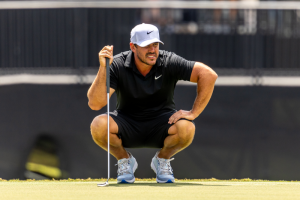
Joaquin Niemann +2800 (BetRivers)
Full disclosure, I bet Niemann the second he was invited to The Masters back in February at +8000. Although the odds have shortened dramatically since then, I can’t pretend that the Chilean isn’t one of the players who has a real chance to win the 2024 Masters.
While I was speaking with Niemann back in March, he told me how much he loves Augusta National.
“Yeah, it’s a place that I love. I’ve been playing good golf. Especially last year, I wasn’t playing my best golf, and I had a good week there and made triple on 11 that kind of killed me a little bit.
I feel like I’m getting more ready and more prepared every time. My game is getting better too. I know that I’m playing good enough to be in that situation that I can have a chance to win the Masters and it’s all about how I react to that situation.
So yeah, I’m going to prepare myself to be ready for that situation if it happens and I can fight for the title on the Sunday which would be awesome.”
As Niemann alluded to, the Chilean was able to have his best career finishes at The Masters (T16) despite not being in the best form. This year, Niemann comes into the week playing better golf than anyone in the world with the exception of Scottie Scheffler. The 25-year-old has won three times since December and has shown the world why he was regarded as one of the games future stars since he was a teenager.
Historically speaking, Joaco’s win at Riviera a few years back seems to be an indicator of potential success at Augusta National. Fourteen players have won at both historic courses including Hideki Matsuyama, Jon Rahm, Phil Mickelson, Dustin Johnson, Nick Faldo, Tom Watson and Ben Hogan.
Niemann has all the shots to be successful at Augusta National. His low stingers will come in handy on plenty of holes down the stretch and he can work it both ways, playing the high draw or the low fade. He also putts best on Bentgrass greens and likes them fast. Whether PGA Tour or LIV, talent will always reign supreme, and I’ll always bet on that talent.

Cameron Smith (+4000) (FanDuel)
Cameron Smith is another player who we should get an odds discount on based off of the results at LIV Miami. Smith was forced to withdraw prior to the second round due to food poisoning. In my opinion, the number has drifted to a place where I’d consider it a “bet the number” play on the talent.
Smith is a contender for the green jacket anytime he tees it up at Augusta National. The Australian absolutely loves the golf course and has four top-10 finishes in his last six trips to the golf course. In both 2020 and 2022, Smith had a real chance of winning The Masters and came up just short, finishing T2 and T3 in those two tries. In his past 36 rounds, he ranks 4th in Strokes Gained: Total per round at Augusta.
In order to be successful at Augusta National, players must be creative around the greens and be shot makers who have plenty of ways to get around the golf course. Cam has all the shots required to be successful at the course at his touch around the greens will continue to serve him well in his hopes for a green jacket.
Smith is arguably the best putter in the world and has the capability to win a golf tournament on and around the greens. He’s already taken down Rory McIlroy at the home of golf on his way to a claret jug and is one of the few players who can stare down any of the world’s top golfers on the back nine at Augusta National.

Justin Thomas +4000 (FanDuel)
With how he’s been playing since his 2022 PGA Championship win, you may be shocked to see the name “Justin Thomas” in this preview. However, JT has drifted to a place on the odds board where I believe it’s worth taking a shot on the talent of a two-time major champion in his prime.
It’s not all bad for Thomas this season. He finished T6 at the signature Pebble Beach event, T12 at the Waste Management Phoenix Open and T12 at the signature Arnold Palmer Invitational. In his last 24 rounds, JT ranks 8th in the field in Strokes Gained: Approach, 14th in Strokes Gained: Around the Green and 29th in Strokes Gained: Putting on fast Bentgrass greens.
Despite missing the cut last season, Thomas has played pretty well at Augusta National. He ranks 13th in Strokes Gained: Total in his past 36 rounds at the course. He finished T4 in 2020, T21 in 2021 and T8 in 2022.
I believe the 2024 edition of The Masters is completely wide open. The past few years has been frustrating for Thomas fans, but I believe his peak form may be a bit closer than people realize.
Sergio Garcia +12000 (FanDuel)
Earlier this season, Garcia dueled with Joaquin Niemann before finally losing on the fourth playoff hole late into the night. Despite the loss, the 44-year-old seemed to gain confidence in his game. The results that followed weren’t spectacular, but in terms of his ball striking he’s shown some flashes of vintage Sergio.
At LIV Miami last week, Garcia played well on a massive golf course, losing in a playoff to Dean Burmester. He continued pumped the ball into the fairway and hit massive iron shot after massive iron shot. He also used a refurbished Scotty Cameron that he used in the 1999 PGA Championship at Medinah. The putter served him incredibly well until he missed a short putt on the 18th hole to win the event. Overall, he gained 7.1 strokes putting at Doral.
Sergio Garcia is once again headed to Augusta National with a chip on his shoulder. Of course, having a chip on the shoulder is nothing new for the fiery Spaniard, but this year, the 2017 Masters Champion will arrive at Augusta with his game clicking on all cylinders.
Sergio winning a second green jacket is seemingly an almost impossible feat, but magical things tend to happen on the hallowed grounds of Augusta National.
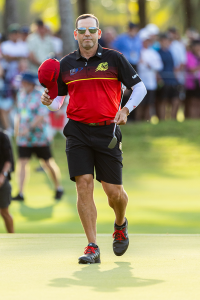
Adam Scott +11000 (FanDuel)
Betting Adam Scott over the past handful of years has been a Masters staple for me, and like many traditions, has been a hard one for me to let go of.
Last week, Scott finished T14 at the Valero Texas Open in a windy and difficult week. I believe the wind will be a major factor this week at Augusta National, and the more difficult the tournament plays, the more I favor Scott. Scott also ranks 5th in his past 24 rounds on Strokes Gained: Putting on Fast Bentgrass and has the short game these days that could help him contend in a major.
Since his win in 2013, Scott’s history at The Masters has been spotty. He has some poor finishes alongside a T9 in 2017 and a T18 in 2019. He’s been playing some solid golf this season, finishing T8 at the Waste Management Phoenix Open and T19 at the Genesis Invitational.
(All photos in piece belong to LIV Golf)
- LIKE35
- LEGIT22
- WOW8
- LOL2
- IDHT0
- FLOP5
- OB1
- SHANK17
Opinion & Analysis
The 22 players who can win the Masters
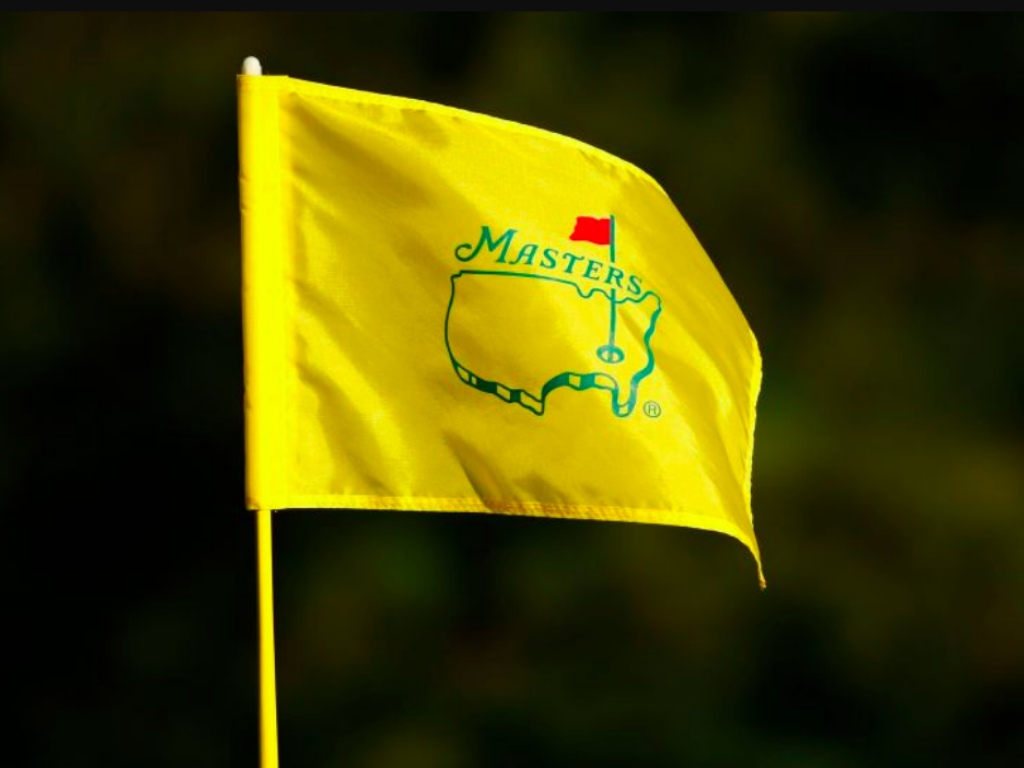
Since 2013, I have created a filtering process to help determine the players who are most likely to win the green jacket based on criteria that have strongly predictive outcomes to success at Augusta. The list of players that can win at Augusta is usually filtered down to 20-24 players and in that time I have correctly shortlisted every Masters champion.
This includes last year’s winner, Jon Rahm. Even though Rahm essentially walked away with the green jack and did not make it very close, there were some close calls on top of the leaderboard as I had filtered out Phil Mickelson (t-2nd) and Patrick Reed (t-4th) as the LIV Tour is still behind on providing advanced analytics for their tour. Russell Henley was also filtered out and finished t-4th, five strokes from Rahm’s winning score of 276.
If you’re watching at home, the “critical holes” that will likely determine the top finishers will be holes No. 7, 8, 11 and 13. The 11th hole is projected to be the most critical of holes as over the past five Masters the top players have gained nearly a 1.5 strokes for the tournament on that hole alone.
Just like last year’s column I will get the LIV Tour players I’ve filtered out of the way. Since LIV Tour does not provide ShotLink or Trackman data, it’s more of a guessing game as to how certain LIV Tour golfers are playing. I did utilize recent performance as well as performance at Mayakoba and Doral as they were two former PGA Tour courses that have some semblance of crossover to playing Augusta.
Phil Mickelson
Thorbjorn Olesen
Charl Schwartzel
Cameron Smith
Bubba Watson
Admittedly Cameron Smith and Phil Mickelson are hard to leave out, but both have not played well as of late.
Next, I filtered out the amateurs and all first-time professional attendees. The Masters has only been won three times by a first-time attendee: Fuzzy Zoeller was the last to win in 1979. Prior to Zoeller though, it was Horton Smith in the inaugural event in 1934 followed by Gene Sarazen in 1935
Ludvig Aberg
Akshay Bhatia
Wyndham Clark
Eric Cole
Santiago de la Fuente (a)
Nick Dunlap
Austin Eckroat
Stewart Hagestad (a)
Ryo Hisatsune
Lee Hodges
Nicolai Hojgaard
Stephan Jaeger
Jake Knapp
Christo Lamprecht (a)
Peter Malnati
Denny McCarthy
Grayson Murray
Matthieu Pavon
Adam Schenk
Neal Shipley (a)
Jasper Stubbs (a)
Out of the first time invitees the data likes Ludvig Aberg and Eric Cole to play the best at Augusta National.
I also filter out old Masters champions that I do not believe can get into contention anymore.
Fred Couples
Jose Maria Olazabal
Vijay Singh
Mike Weir
Tiger Woods
Recency has a strong predictive value for player performance and missing the cut in the event in the prior week greatly reduces the likelihood of winning the following week compared to players that miss the cut, take a week off, and then play the following week. Therefore I filter out all players that missed the cut at the Valero Texas Open last week.
Byeong Hun An
Harris English
Rickie Fowler
Ryan Fox
Zach Johnson
Tom Kim
Erik van Rooyen
Camilo Villegas
I will also filter out the players that have never made the cut at the Masters:
Kurt Kitayama
Adrian Meronk
A Tradition Unlike Any Other…
Augusta National has traditionally favored longer hitters and even moreso in the past 20 years of the event. Of course there has been exceptions as in 2007 the short hitting Zach Johnson ended up winning the event.
Critics of my filtering system point out Johnson’s victory as a case for short hitters being able to win at Augusta, but they neglect the fact that Johnson’s victory came in historically low temperatures in the 40’s with wind gusts reaching 35 mph. That made the par-5’s almost unreachable in two shots and the course stressed wedge play and short game around the green where Zach had a sizable advantage.
It is projected to rain early on Thursday and then the weather is supposed to be sunny and warm for the rest of the week. It depends on how quickly the course dries up, but if it does dry out fairly quickly that will give the longer hitters the advantage as they will be able to reach certain par-5’s in two shots that the shorter hitters cannot reach if they don’t hit a quality tee shot and there may be par-5’s that some of the long hitters can reach in two shots with a short iron. Therefore I will filter out the following players due to a lack of distance off the tee:
Corey Conners
Lucas Glover
Emiliano Grillo
Brian Harman
Si Woo Kim
Chris Kirk
Shane Lowry
Colin Morikawa
JT Poston
Justin Rose
Sepp Straka
Out of these players the data likes Lowry and Morikawa the most. Both have good history at Augusta and they both just narrowly missed the distance benchmark set in the filter and both are excellent long iron players.
Last year I created a new formula to better determine ball height as Augusta has historically not taken too kindly to a low ball flight. Out of the 5 players filtered out for low ball flight using the new formula the best finish was only t-29th by Si Woo Kim. This year I’ve filtered out the following players.
Matthew Fitzpatrick
Sungjae Im
Luke List
Joaquin Niemann
Justin Thomas
Every year I filter out the poor performers on approach shots from 175-225 yards as Augusta National puts a lot of stress on those shots. Last year I filtered out nine players and three of them missed the cut with only Jordan Spieth finishing in the top-15 (t-4th) as the rest of the players were never a threat.
Here are the golfers I’m filtering out due to poor play from 175-225 yards:
Patrick Cantlay
Cameron Davis
Jason Day
Tommy Fleetwood
Russell Henley
Max Homa
Rory McIlroy
Jordan Spieth
Nick Taylor
Rory had a nice outing at the Valero Texas Open and hit his irons better there, but appears to be struggling with a leftward miss. Other than that, Rory still has the game to win his first green jacket. Henley is usually one of the better iron players on Tour, but he has struggled this season from 175-225 yards and is a short hitter anyway.
I will also filter out Danny Willett as he is coming off injury and making his comeback at the Masters.
That leaves the 22 players that can win the Masters:
Keegan Bradley (150/1)
Sam Burns (60/1)
Bryson DeChambeau (25/1)
Tony Finau (50/1)
Sergio Garcia (100/1)
Adam Hadwin (175/1)
Tyrrell Hatton (80/1)
Viktor Hovland (35/1)
Dustin Johnson (40/1)
Brooks Koepka (16/1)
Min Woo Lee (70/1)
Hideki Matsuyama (20/1)
Taylor Moore (300/1)
Jon Rahm (12/1)
Patrick Reed (80/1)
Xander Schauffele (18/1)
Scottie Scheffler (4/1)
Adam Scott (100/1)
Sahith Theegala (50/1)
Gary Woodland (250/1)
Cameron Young (50/1)
Will Zalatoris (35/1)
Here’s my personal top-10 picks:
Keegan Bradley (150/1)
Sam Burns (60/1)
Bryson DeChambeau (35/1)
Tony Finau (50/1)
Viktor Hovland (35/1)
Dustin Johnson (40/1)
Hideki Matsuyama (20/1)
Jon Rahm (12/1)
Xander Schauffele (18/1)
Scottie Scheffler (4/1)
- LIKE180
- LEGIT74
- WOW23
- LOL25
- IDHT5
- FLOP11
- OB6
- SHANK60
-

 19th Hole2 weeks ago
19th Hole2 weeks agoJohn Daly stuns fans into silence with brutal opening tee shot on PGA Tour Champions
-

 19th Hole1 week ago
19th Hole1 week agoThings got heated at the Houston Open between Tony Finau and Alejandro Tosti. Here’s why
-

 19th Hole1 day ago
19th Hole1 day agoDave Portnoy places monstrous outright bet for the 2024 Masters
-

 19th Hole2 days ago
19th Hole2 days agoTiger Woods arrives at 2024 Masters equipped with a putter that may surprise you
-

 19th Hole1 week ago
19th Hole1 week agoReport: Tiger Woods has ‘eliminated sex’ in preparation for the 2024 Masters
-

 19th Hole2 weeks ago
19th Hole2 weeks agoCharlie Woods finds it tough going on American Junior Golf Association debut
-

 19th Hole1 week ago
19th Hole1 week agoAddiction, spinal fusion, and scam artists – Everything Anthony Kim revealed in candid interview with David Feherty
-

 19th Hole6 days ago
19th Hole6 days agoAnthony Kim says doctors told him that he ‘may not have much time left’ ahead of LIV return

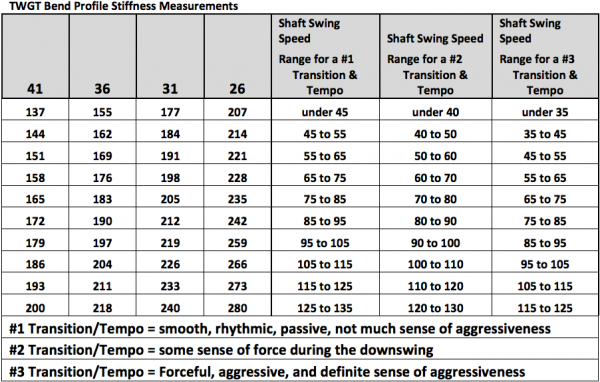
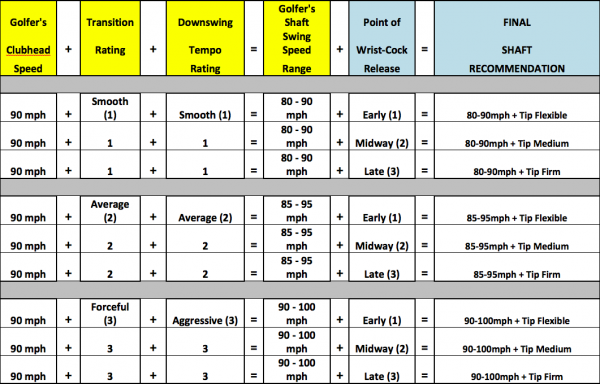


















Pingback: The Difference in Using Custom Fitted Golf Shafts | Golf Gear Select
ron
Aug 14, 2013 at 4:38 pm
please provide advise on shaft replace for RBZ stage 2 9.5 driver
ss – 94 mph
downswing tran – little aggresive
middle release
Pingback: All About Customizing Golf Shafts | Golf Gear Select
Pingback: Facts About Shaft Fitting | Golf Gear Select
Martin
Jan 17, 2013 at 9:33 pm
Based on the article I just read I would recommend Ckua 43 Miyazaki shaft, regular flex. Flexible tip and stiffer on the butt. Wonder what Mr Wishon thinks on my recommendation? 🙂
pistol44
Nov 9, 2012 at 11:56 am
sorry, thx for your input if you can provide any!!!
much appreciated
pistol44
Nov 9, 2012 at 11:55 am
please provide advise on shaft replace for rocketballs 10.5 driver
ss – 94 mph
downswing tran – little aggresive
middle release
like to get more carry. LM indicates launch angle of 9 degrees
Todd
Oct 25, 2012 at 10:06 pm
Nice, Tom! Must say, though….in this age of high-tech gadgetry, its rather lacking that your typical “expert” clubfitter isn’t actually MEASURING the bend you put on the shaft. At the end of the day, if you’re not measuring, then your just guessing.
Blanco
Oct 25, 2012 at 5:08 am
Much props for putting such detailed and important info into such an easy to read piece. I hope to see these charts on the walls of large retail fitting stalls.
Plus8
Oct 23, 2012 at 7:38 am
Great article and I agree with the summation! My own experience of having self-styled ‘fitters’ has shown that many folks do not consider any transition, downswing speed, or wrist release (a MOST important factor for me, since I work on a late wrist release a lot). In fact I had a club pro tell me based on my age and without even looking at me, I needed a reg shaft, but in actually my reg, tip flexible shafts performed terribly for me and a stiffer, less-tip-flex performs wildly better with my transition and wrist. The only shame here is that so many folks are blindly following misinformed ‘fitters’ when the Wishon data clarifies the elements so well. Not a rant, just an affirmation.
Joe Golfer
Oct 22, 2012 at 1:01 am
Very good article. As far as finding that “specific preference to the bending feel of a shaft”, it seems like one just has to keep trying a myriad of shafts in order to find that specific shaft that has the right feel to that golfer. I know that Mr. Wishon has software that compares many shafts to one another, telling you which shafts have similar frequencies all the way up and down the shaft, from butt to tip.
I wonder if there’s any correlation between swing type and those other characteristics of the shaft.
For example, in this article we learned about increased tip stiffness being related to a late release.
If one looks up shafts like Diamana’s White Board, Blue Board, and Red Board, one finds that the company lists different characteristics not just for the tip, but also for the butt profile and the middle of the shaft profile.
I wonder if Mr. Wishon has any data and recommendations on preferences of specific swing types as they relate to the butt and middle of shaft profiles, just as he has noted a recommendation regarding tip stiffness.
Johnny
Oct 17, 2012 at 11:59 am
Note to the editors – excellent information! I believe you need to check the chart TGWT bend profile stiffness, seems the #1 and #3 golfer are switched.
Bob
Oct 17, 2012 at 11:33 am
We all know Sergio swings a really short driver, but it also looks like (in this picture) that it is back weighted too.
Peter Wentzlaff
Oct 12, 2012 at 8:29 am
Excellently explained how a shaft corresponds to a swing or vice versa.
Even for a non perfect English speaking German easily to understand.
Thousand Thank´s
Tyler Summerhays
Oct 10, 2012 at 11:03 am
I’m happy to report that for a majority of my playing life I have enjoyed Mr. Wishon’s clubs both when he was with Golfsmith and now with his own company. In the past 3 years I have played shafts using his Shaft to Swing system and am happy to report that it’s been an improvement in my game, especially with my driver. I was a little hesitant about using one of his shafts because of my ego but I thought it was worth a try and the shaft hasn’t left my driver since. Now I have a greater amount of confidence that my driver will perform how I want it to when I make a good swing.
Devin Drayton
Oct 7, 2012 at 10:51 am
Excellent!!!
Extremely simple to understand, Bravo!